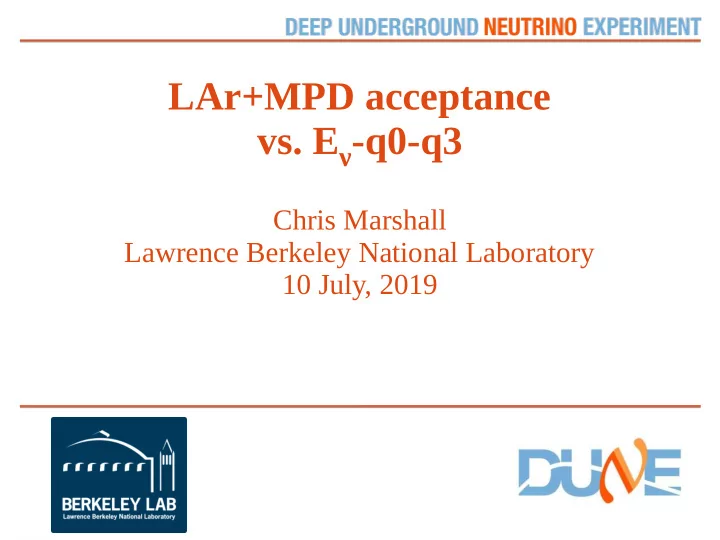

LAr+MPD acceptance vs. E ν -q0-q3 Chris Marshall Lawrence Berkeley National Laboratory 10 July, 2019
Reminder: LAr acceptance ● LAr detector will have very high event rate, and does not necessarily need high acceptance ● However, it would be very bad if a particular region of phase space had zero acceptance, because then we would have no constraint on that phase space ● Important question is not what is the acceptance, but what fraction of events have non-zero acceptance ● We also want acceptance to be slowly varying vs. kinematics so that it is not sensitive to detector modeling 2 Chris Marshall
Detector as seen by ν beam (XY projection) 7m Active volume F.V. 3m hadron tracks 3 Chris Marshall
Same event, translated 7m Active volume F.V. 3m 4 Chris Marshall
Event that is not contained with any translation 7m Active volume F.V. 3m 5 Chris Marshall
But is using phi symmetry 7m Active volume F.V. 3m 6 Chris Marshall
Plot from previous study ● Shows that cross section coverage is high, and slowly varying vs. neutrino energy for detectors that are >450cm long ● Implies that there are no acceptance holes in the flux peak, because >99% of cross section has non-zero acceptance 7 Chris Marshall
Acceptance vs. q0-q3 ● Reviewer of the ND CDR-lite document suggested that what we should show is acceptance vs. q0-q3 in slices of neutrino energy ● q0 = energy transfer to nucleus ● q3 = 3-momentum transfer to nucleus 8 Chris Marshall
q0-q3 distributions 3.5 < E ν < 4 GeV 1 < E ν < 2 GeV ● True q0-q3 distributions in GENIE for two slices of neutrino energy ● Two populations at low momentum transfer are CCQE and Δ resonance ● q0=q3 is Q 2 →0 kinematic limit ● Lower-right corner is high muon angle 9 Chris Marshall
Acceptance: 0 < Eν < 1 GeV ● Caveat: this is actually selected CC ν μ events, so there is an additional requirement that isn't related to acceptance: the muon must be long enough to identify as a muon and not a pion ● Upper-right corner efficiency is low because muon is very soft 10 Chris Marshall
Acceptance: 1 < Eν < 2 GeV ● Black regions on the right plot (log scale) are basically <1% acceptance ● These are effectively “acceptance holes”, but we can't say if it's 1% or 0 with this level of MC statistics 11 Chris Marshall
Acceptance: 2 < Eν < 2.5 GeV ● Basically > few% acceptance everywhere, and very high acceptance at low momentum transfer 12 Chris Marshall
Acceptance: 2.5 < Eν < 3 GeV ● Basically > few% acceptance everywhere, and very high acceptance at low momentum transfer 13 Chris Marshall
Acceptance: 3 < Eν < 3.5 GeV ● Basically > few% acceptance everywhere, and very high acceptance at low momentum transfer 14 Chris Marshall
Acceptance: 3.5 < Eν < 4 GeV ● Basically > few% acceptance everywhere, and very high acceptance at low momentum transfer 15 Chris Marshall
Acceptance: 4 < Eν < 5 GeV ● Basically > few% acceptance everywhere, and very high acceptance at low momentum transfer 16 Chris Marshall
Acceptance: 5 < Eν < 6 GeV ● Basically > few% acceptance everywhere, and very high acceptance at low momentum transfer ● Small hole at high muon angle, but very, very few events 17 Chris Marshall
Acceptance: 6 < Eν < 8 GeV ● Basically > few% acceptance everywhere, and very high acceptance at low momentum transfer ● Small hole at high muon angle, but very, very few events 18 Chris Marshall
Acceptance: 8 < Eν < 10 GeV ● Basically > few% acceptance everywhere, and very high acceptance at low momentum transfer ● Small hole at high muon angle, but very, very few events 19 Chris Marshall
Fraction of events in Eν-q0-q3 regions with acceptance ● >99% have non-zero acceptance out to 10 GeV ● >98% have >2% acceptance out to 5 GeV 20 Chris Marshall
Acceptance is high in peak region ● Acceptance is >30% for most q0-q3 regions in the flux peak, and >50% for a lot of the space 21 Chris Marshall
Conclusions ● 7x3x5m detector has no significant acceptance holes, including muon + hadron containment ● Acceptance vs. q0-q3 is high in region where most events are, and has a region of low acceptance at high Q2 and higher neutrino energy ● Most of the cross section is in phase space with high acceptance 22 Chris Marshall
Recommend
More recommend